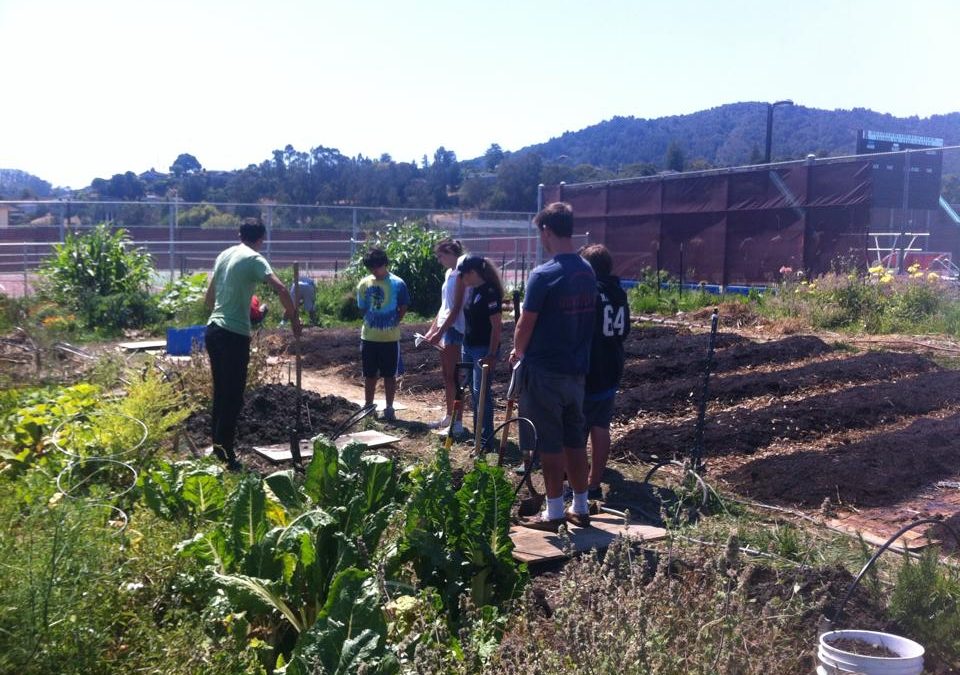By Cleary Vaughan-Lee
Have you ever considered your relationship to nature and how it might be influenced by the impacts of technology? This is a thought I explored recently with students at Redwood High School in Larkspur, California during their annual Sustainability Festival.
Redwood High School, a National Blue Ribbon School, is nestled in Marin County, just a few miles north of the Golden Gate Bridge. For ten years, Joe Stewart, an environmental science teacher—whose classes include AP environmental science, ecology, and sustainable agriculture—has organized a sustainability festival that takes place for a week each May. Throughout the week, students are encouraged to bike to school, eat locally, and participate in environmental restoration. In 2013, Stewart initiated an expansion of the school’s garden to include an 8000 square foot mini-farm run by the sustainable agriculture students. Approximately 40 workshops are offered during the sustainability festival from 20 local organizations, including mine, the Global Oneness Project.
Since I only had 45 minutes to spend with students, I screened a short film and engaged students in a classroom discussion and a reflective writing prompt. The aim was for students to consider their own relationship to nature.
To get the conversation started, I asked the students— What do you like to do in nature? And, What benefits do you think nature has to offer? Students listed some of the pros and cons of being indoors versus outdoors. Some of the pros of being indoors, students said, included access to technology (including computers and television) and being comfortable, in regards to temperature, bedding, furniture, etc. Some of the pros of being outdoors included sunshine, recreational activities such as biking and running, vitamin D, and the improvement of one’s quality of life. The cons included poor air quality and allergies.
After this conversation, I shared a short film, Into the Middle of Nowhere, by Anna Ewert. This film documents an outdoor preschool in Fife, Scotland where 3-5 year-olds use their imagination while playing in the woods. Students enjoyed the young children’s Scottish accents and spontaneous play. After watching the film, we engaged in a classroom discussion, dissecting the film and identifying the components they thought connected the young preschool students to nature. Everyone agreed that imagination and creativity soar when being in nature.
In the final 15 minutes of our workshop, I shared with students a statement from a 4th grader who is quoted at the beginning of Richard Louv’s book, Last Child in the Woods, Saving Our Children from Nature-Deficit Disorder: “I like to play indoors better ’cause that’s where all the electrical outlets are.”
Using a writing prompt from the film’s accompanying lesson plan, I asked students to consider this question: If you were to write a letter to persuade this 4th grader to play outdoors, what would you write? Students could describe their own experiences based on their relationship to technology and nature to prove their argument. They could also include some of the benefits of nature that they’ve experienced as well as some of the negative impacts and influences of technology and electronics. Here is one student’s response, which encapsulates her understanding of the story and the need to not only be outdoors, but to create a relationship with the natural world:
Dear 4th grader,
Have you ever heard someone say the words “natural beauty?” You are right, electrical outlets are pretty great, but have you ever seen a waterfall overflowing with water? iPhones are also a great way to pass time, but have you ever seen a meadow of flowers in full bloom? Candy Crush can become a lifestyle, but have you ever felt the warmth of sunshine hug you when you weren’t expecting it? You live in a world of natural beauty. Go explore.
Cleary Vaughan-Lee is the Education Director at the Global Oneness Project, an online multimedia platform that offers free multicultural stories and accompanying curricula. Since creating the project’s education program, she has conducted numerous K20 trainings across the country and has presented at various regional and national conferences including ISTE, NCCE, and NMC. Cleary is a regular contributor to TED-Ed and Education Week. The Project’s films and lessons have been featured in The New York Times, National Geographic, PBS Learning Media, and the Smithsonian, among others.
Photo Courtesy of Joe Stewart

